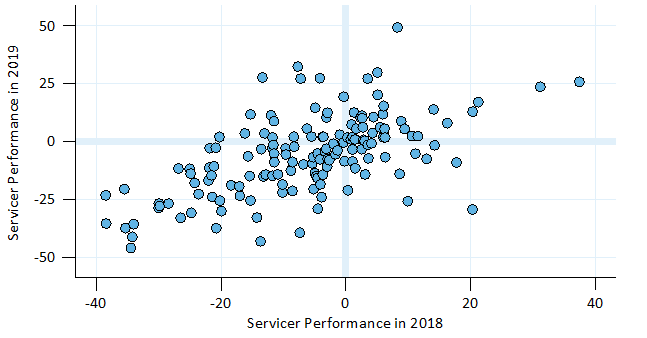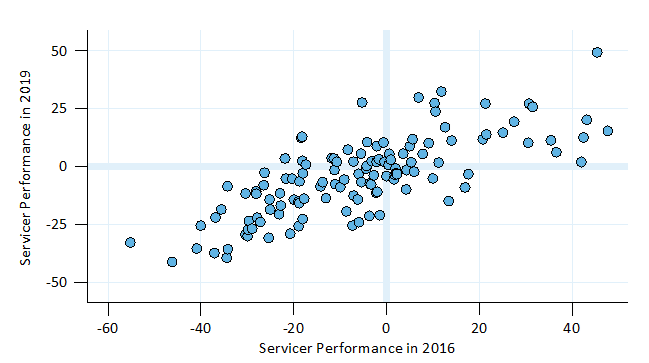Uncategorized
Getting a lead on servicers’ need for speed
admin | February 28, 2020
This document is intended for institutional investors and is not subject to all of the independence and disclosure standards applicable to debt research reports prepared for retail investors. This material does not constitute research.
Mortgage servicers clearly have an impact on whether borrowers prepay, and comparing servicer performance in 2018 and 2019 shows that slower servicers tend to remain slower and faster servicers tend to remain faster. However, the market matters. Servicer speeds in years with heavy refinancing correlate more strongly with other refi years than with years where turnover becomes a bigger part of the mix.
Servicer prepayment behavior in 2018 helped predict speeds in 2019
Comparing servicers’ relative prepayment performance from 2018 to 2019 shows a correlation of 0.59 year-over-year for the 150 largest conventional servicers (Exhibit 1). A positive number indicates the servicer’s loans prepay faster than expected. Most fast servicers remained fast, and slow servicers remained slow—112 servicers, almost 75% of the sample, did not flip across the average speed line from 2018 to 2019.
Exhibit 1: Servicer performance in 2018 helped predict speed in 2019

Note: Servicer performance is the percentage faster or slower that servicer’s loans prepaid compared to a comparable cohort of all loans. The comparison controls for a servicer’s mix of factors such as loan balance and geography to try to measure a servicer’s unique contribution. A score of +25 represents 25% faster than the market benchmark, and -25 represents 25% slower. Performance in 2018 includes the 12 months ending December 2018, and performance in 2019 includes the 12 months ending December 2019. Data includes Fannie Mae and Freddie Mac 30-year fixed rate loans. Source: Fannie Mae, Freddie Mac, eMBS, Amherst Pierpont Securities
Servicer performance isn’t perfectly correlated from year to year. United Shore, for example, was slightly slower than average in 2018. However, that servicer priced mortgages more aggressively in 2019, causing the servicer to become one of the fastest servicers. Another difference is that 2018 was primarily a turnover environment while 2019 was primarily a refinance environment. A servicer with aggressive refinancing practices won’t necessarily be faster when purchase loans dominate production.
Comparing 2019 servicer performance to 2016 pairs two years with relatively heavy refinancing—refinanced loans were roughly 53% of GSE production in both years. The correlation between servicer performance from 2016 to 2019 is stronger at 0.75, suggesting that servicers’ refinancing behavior is roughly consistent, although other factors beyond servicer alone also matter even after controlling for loan balance, geography and the like.
Exhibit 2: Servicer performance in 2019 is more strongly correlated to the refinance environment of 2016.

Note: Servicer performance is the percentage faster or slower that servicer’s loans prepaid compared to a comparable cohort of all loans. The comparison controls for a servicer’s mix of factors such as loan balance and geography to try to measure a servicer’s unique contribution. A score of +25 represents 25% faster than the market benchmark, and -25 represents 25% slower. Performance in 2018 includes the 12 months ending December 2018, and performance in 2019 includes the 12 months ending December 2019. Data includes Fannie Mae and Freddie Mac 30-year fixed rate loans. Source: Fannie Mae, Freddie Mac, eMBS, Amherst Pierpont Securities
The market routinely trades pools from different servicers at different prices in expectation of different prepayment speeds. The data show good reasons for that, especially when markets become dominated by refinancing.
This material is intended only for institutional investors and does not carry all of the independence and disclosure standards of retail debt research reports. In the preparation of this material, the author may have consulted or otherwise discussed the matters referenced herein with one or more of SCM’s trading desks, any of which may have accumulated or otherwise taken a position, long or short, in any of the financial instruments discussed in or related to this material. Further, SCM may act as a market maker or principal dealer and may have proprietary interests that differ or conflict with the recipient hereof, in connection with any financial instrument discussed in or related to this material.
This message, including any attachments or links contained herein, is subject to important disclaimers, conditions, and disclosures regarding Electronic Communications, which you can find at https://portfolio-strategy.apsec.com/sancap-disclaimers-and-disclosures.
Important Disclaimers
Copyright © 2024 Santander US Capital Markets LLC and its affiliates (“SCM”). All rights reserved. SCM is a member of FINRA and SIPC. This material is intended for limited distribution to institutions only and is not publicly available. Any unauthorized use or disclosure is prohibited.
In making this material available, SCM (i) is not providing any advice to the recipient, including, without limitation, any advice as to investment, legal, accounting, tax and financial matters, (ii) is not acting as an advisor or fiduciary in respect of the recipient, (iii) is not making any predictions or projections and (iv) intends that any recipient to which SCM has provided this material is an “institutional investor” (as defined under applicable law and regulation, including FINRA Rule 4512 and that this material will not be disseminated, in whole or part, to any third party by the recipient.
The author of this material is an economist, desk strategist or trader. In the preparation of this material, the author may have consulted or otherwise discussed the matters referenced herein with one or more of SCM’s trading desks, any of which may have accumulated or otherwise taken a position, long or short, in any of the financial instruments discussed in or related to this material. Further, SCM or any of its affiliates may act as a market maker or principal dealer and may have proprietary interests that differ or conflict with the recipient hereof, in connection with any financial instrument discussed in or related to this material.
This material (i) has been prepared for information purposes only and does not constitute a solicitation or an offer to buy or sell any securities, related investments or other financial instruments, (ii) is neither research, a “research report” as commonly understood under the securities laws and regulations promulgated thereunder nor the product of a research department, (iii) or parts thereof may have been obtained from various sources, the reliability of which has not been verified and cannot be guaranteed by SCM, (iv) should not be reproduced or disclosed to any other person, without SCM’s prior consent and (v) is not intended for distribution in any jurisdiction in which its distribution would be prohibited.
In connection with this material, SCM (i) makes no representation or warranties as to the appropriateness or reliance for use in any transaction or as to the permissibility or legality of any financial instrument in any jurisdiction, (ii) believes the information in this material to be reliable, has not independently verified such information and makes no representation, express or implied, with regard to the accuracy or completeness of such information, (iii) accepts no responsibility or liability as to any reliance placed, or investment decision made, on the basis of such information by the recipient and (iv) does not undertake, and disclaims any duty to undertake, to update or to revise the information contained in this material.
Unless otherwise stated, the views, opinions, forecasts, valuations, or estimates contained in this material are those solely of the author, as of the date of publication of this material, and are subject to change without notice. The recipient of this material should make an independent evaluation of this information and make such other investigations as the recipient considers necessary (including obtaining independent financial advice), before transacting in any financial market or instrument discussed in or related to this material.




